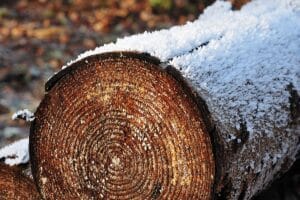Every once in a while a media light shines on a leafy corner of the investment world, and the observer says, “My, my. Who knew?”
The most recent example is Jeff D. Opdyke’s column in the Wall Street Journal, “Wealthy Investors Discover Timberland”.
Opdyke got some of this story right—average annual timberland returns since 1987 have exceeded equities by almost five percent; timberland is less subject to market exuberances and the risky systemic consequences of Wall Street’s leveraged betting; timberland value is real not virtual (in the many senses of both words); and timberland does carry risks from natural forces and macro-economic downturns.
I offered the case for land, including timberland, over stocks two years ago in my weekly column, “Country Real Estate,” “Stocks vs. land: Which is the better investment?”.
But Opdyke reaches the wrong conclusion, that timberland is a play only for wealthy and large institutional investors, not the little guys.
Opdyke writes: “Despite all the positives…the timber business has so many quirks that the asset class makes sense only for ultrawealthy, ultralong-term investors. …Timberland investing works best at scale, making it a difficult investment for people of lesser means. Small plots don’t have the muscle to generate meaningful income, since only a fraction of the trees are culled at any one time.” With the average Southeast timber tract at about 400 acres, “at roughly $2,000 an acre, that is an $800,000 ante just to play.”
My experience, both personal and as a consultant to timberland investors of all sizes over a number of years, differs from Opdyke’s opinion. Whether a timberland investment works or not has little to do with its size (which can always be reduced almost immediately by profitable off-conveyances as part of the acquisition strategy, if nothing else). It has to with the terms of the deal and the thoroughness of the investor’s research and analysis.
Profit in timberland is made by an investor scoping the component assets of the timberland tract (merchantable timber; premerchantable timber; stumpage-price trends and local markets; land valued as timberland; land valued as Higher-and-Better-Use property; conservation-easement value (particularly as a Working Forest CE); environmental values and constraints; non-timber energy uses (wind, carbon offset credits, solar, geothermal, subsurface minerals, etc.); assets that can be sold quickly and those that are core to the investment plan; and tax benefits (land-use status at the local level as one example), among others.
Every investor — big or small — must value these assets individually and collectively to determine his plan for the investment and the acquisition price that leads to profit, given his plans and resources judged against risks and liabilities. This is an analytical process unrelated to the size of the timberland tract. It’s a process that small investors can master with consulting help; it’s not knowledge that’s available only to timberland REITs, TIMOs and billionaires.
While I applaud Opdyke’s venture into the woods, it’s clear that he doesn’t quite understand where he is. Since I’ve made navigational mistakes of this kind in print as well over the years, it’s worth pointing out several.
First, Opdyke is generalizing conclusions about timberland investing from the fairly specific case of Southeast, even-age pine plantations on a 25-year rotation. Management — when to cut, the type of cut, among other factors — of uneven-age hardwood stands and mixed pine/hardwood stands is different. Naturally regenerated hardwood stands are not “high-maintenance,” in Opdyke’s words, and can be harvested selectively (not high-grading) every 15 to 20 years to produce income, upgrade the stand’s species and improve its productivity.
Second, Opdyke doesn’t distinguish clearly between returns on timber sales and return on overall investment.
An individual with 50 to 100 acres of even-age Southeast, planted pine should be able to equal or better the timber-sale returns of the owner of 100,000 acres, acre to acre, because the little guy’s management and overhead costs should be lower and stumpage prices should be roughly the same. Large-scale operations don’t make trees grow any faster or better than small-scale operations using the same methods on the same ground in the same growing conditions. Having offered that opinion, I know of no apples-to-apples research to prove it…or disprove it.
Overall returns on timberland investments, acre to acre, from purchase to sale, are hard to compare meaningfully — large tracts against small — because individual results depend on many variables. It’s arguable that larger tracts show better overall returns because the acquisition price per acre is likely to be lower with large tracts. But it all depends on the comparative spreads between total investment costs and total investment income all things considered. And in that sense it’s very hard to find apple-to-apple comparisons of timberland investments that differ only in size.
The Southeast, I should add, is full of “small” investors who have built their wealth with timberland. It’s an investment that allows safe leveraging and often instant, tax-deferred mortgage pay down through timber sales.
Third, Opdyke is not clear in his own mind when he writes about timberland prices as against stumpage prices. He writes: “Timberland prices also are susceptible to market dynamics. They have fallen from about $40 a ton to less than $30 during the housing slump, for example.”
I think he’s giving stumpage-price numbers for pine sawtimber in the Southeast, which are not the “timberland prices” referenced in his preceding sentence. Timberland prices are certainly susceptible to market dynamics, but they are not always a function of stumpage prices; other factors are always in play.
I should also mention that the price dive that timberland REITs took when housing crashed was much more severe than that endured by any of the individually owned small timberland tracts with which I’m familiar. I’m not saying that these REITs are bad investments; I’m simply making the point that owned timberland is likely to be less volatile and perform better overall if it’s acquired at the right money with all due diligence in place.
Finally, it should be noted that the “illiquidity” of timberland as an investment is an opinion that’s easily reached and often misleading. Relative to mutual funds, REITs and stocks, property ownership of any kind is illiquid. Timberland is also illiquid when it’s priced above market or above its intrinsic asset value. When it is priced right, I’ve never found a lack of willing buyers.
For the small investor, timberland is a buy-and-hold investment that, when bought right, almost never fails to be safe and profitable, certainly compared with the alternatives. It’s a wealth-appreciation path for the little guy at least as much as for bigger guys.
I’m pleased that Opdyke wrote about investing in timberland and hope that interviews with rank-and-file timberland owners will give him a different perspective the next time he takes a walk through these woods.
This content may not be used or reproduced in any manner whatsoever, in part or in whole, without written permission of LANDTHINK. Use of this content without permission is a violation of federal copyright law. The articles, posts, comments, opinions and information provided by LANDTHINK are for informational and research purposes only and DOES NOT substitute or coincide with the advice of an attorney, accountant, real estate broker or any other licensed real estate professional. LANDTHINK strongly advises visitors and readers to seek their own professional guidance and advice related to buying, investing in or selling real estate.









Great rebuttal. I could not have said it better myself. The WSJ article raised awareness on the asset class. That is a positive. However, it discounted the product before an investor could ever get excited.
Nice article, Curtis. Wish you had written it on May 7th instead of May 4th. I’m sure you would have expanded a bit more on that “timberland is less subject to market exuberance” comment.
All I can say is that my clients who I assisted to self-direct their IRA’s and purchase small tracts of timber and land are much happier than the majority of those who left their IRA money in the Stock Market, Mutual Funds or Bonds!
Couldn’t have said it better myself! My clients I’ve helped self-direct their IRA’s to purchase small timberland tracts are much happier than most people who left their IRA’s in the stock market, bonds and mutual funds.
Almost a year after it was posted, I read this article. I found it insightful and a very good description of timberland investment for smaller investors. As a real estate broker I have been selling timberland for 37 years and have sold timberland to and for small investors, timber companies, REITS, TIMOS, etc. and have seen most of these investors make good returns because the underlying asset offers great opportunities to patient investors.
One advantage that the small investor has over the large investor id a quicker response time to market opportunities.